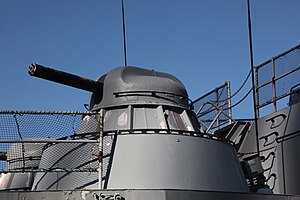GBM-30/6
| GBM-30/6 Bulkkot | |
|---|---|
 GBM-30/6 on the corvette Wang Yŏn-sŏk | |
| Type | Close-in weapon system |
| Place of origin | Menghe, via Letnia |
| Service history | |
| In service | 1978–present |
| Production history | |
| Produced | 1976-present |
| Specifications | |
| Width | 1.25 m (mount base) |
| Height | 1.07 m (above deck) |
| Crew | 1 |
| Shell | 30×165mm |
| Caliber | 30mm |
| Barrels | 6 |
| Action | Gas-operated rotary cannon |
| Elevation | -12 to +88 degrees at 60 degrees/sec |
| Traverse | +/-180 degrees at 70 degrees/sec |
| Rate of fire | 4,000 rounds per minute |
| Muzzle velocity | 880-900 m/s |
| Effective firing range | 4000 m (aircraft) 5000 m (surface) |
| Feed system | belt (2,000 rounds) |
The GBM-30/6 (Formal designation: 근접 방어 무기 30/6, Gujŏb Bang-ŏ Mugi samryŏng-ryuk, "Close-Range Defensive Weapon 30/6") is the Menghean Navy's designation for a license-produced version of the AK-630 close-in weapon system. This system was widely used on Menghean warships during the 1970s, 1980s, and 1990s, but since then it has largely been supplanted by the GBM-23/5 Bulkkot.
Origin
In the early 1970s, Menghe obtained a license from Letnia to produce the AK-230, under the local designation of GBM-30/2. This weapon was mounted on the Nunbora-class destroyers and Plan 261 missile boats. It was found to exhibit good range against aircraft and surface targets, but its rate of fire was inadequate against anti-ship missiles. The Menghean People's Navy responded by adopting the newer AK-630, which uses the GSh-6-30 rotary cannon. The resulting mount had a higher rate of fire, though its lower muzzle velocity also gave it a slightly shorter anti-aircraft range. Foreign intelligence services first observed the new mounts on the new destroyer Yobu in 1979.
Description
The baseline GBM-30/6 CIWS mount is largely identical to the AK-630 from which it is derived. It consists of a GSh-30-6 rotary cannon in a powered turret with a flattened dome-like top. The gun is mounted in a water-cooled sleeve, which allows for more prolonged firing periods before overheating, and it is gas-operated, with a rate of fire of 4,000 rounds per minute. Ammunition feeds from a belt stored underneath the turret, and spent cartridges are ejected into the below-turret space as well. On some Menghean mounts, particularly later ones, the turret floor can be removed, allowing spent cartridges to tumble down a chute out the side of the hull. The ammunition used is the 30×165mm AO-18 high-explosive round, with a muzzle velocity of 880-900 meters per second and an explosive filling which makes it highly effective against missiles and surface craft.
The GBM-30/6 mount lacks built-in fire control, and instead depends on an external fire director, usually an MR-123 Vympel. The baseline version of this radar can only engage airborne targets, and it lacks electro-optical backup. On most ships, the fire-control radar is complemented by a manually pointed optical director, similar to types used in the Pan-Septentrion War, on a separate pedestal. Each guidance unit can control two GBM-30/6 mounts simultaneously; this is easy to see in the gun arrangement of the Yobu and Pyŏng'an class destroyers. On some ships, such as the Ansa-class frigates and pre-refit Chanjok Jachido-class cruisers, the two mounts have different firing arcs, and one turret will stop traversing when the fire-control radar traverses beyond its firing arc.
Variants
- GBM-30/6G
- The baseline version, directly derived from the Letnian early-model AK-630.
- GBM-30/6N
- Upgraded version introduced on the Pyŏng'an class. The fire-control radar has a co-axial electro-optical sight with independent elevation and traverse. This provides an alternative target acquisition and tracking mode in a high-jamming environment and allows more reliable engagement of surface targets. The mounts themselves are identical in design.